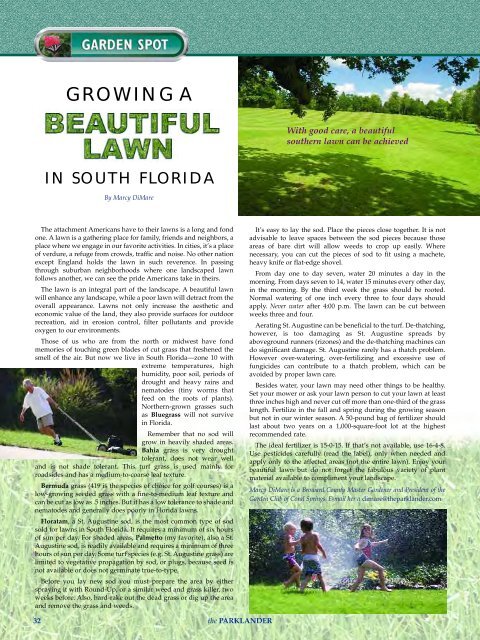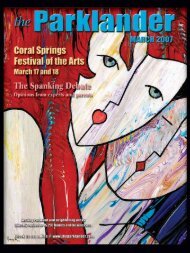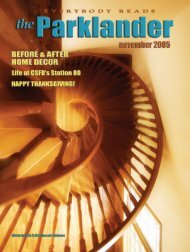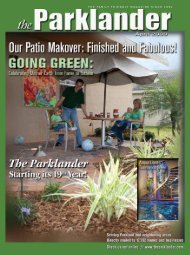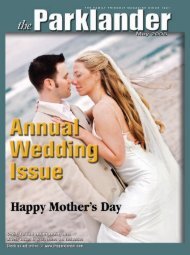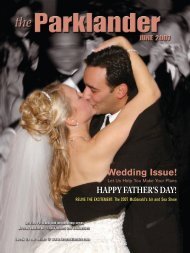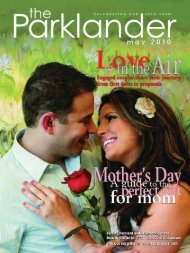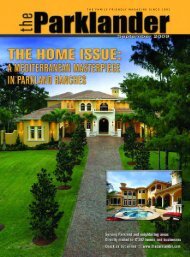June 2006 - The Parklander Magazine
June 2006 - The Parklander Magazine
June 2006 - The Parklander Magazine
- No tags were found...
You also want an ePaper? Increase the reach of your titles
YUMPU automatically turns print PDFs into web optimized ePapers that Google loves.
Growing aWith good care, a beautifulsouthern lawn can be achievedin south floridaBy Marcy DiMare<strong>The</strong> attachment Americans have to their lawns is a long and fondone. A lawn is a gathering place for family, friends and neighbors, aplace where we engage in our favorite activities. In cities, it’s a placeof verdure, a refuge from crowds, traffic and noise. No other nationexcept England holds the lawn in such reverence. In passingthrough suburban neighborhoods where one landscaped lawnfollows another, we can see the pride Americans take in theirs.<strong>The</strong> lawn is an integral part of the landscape. A beautiful lawnwill enhance any landscape, while a poor lawn will detract from theoverall appearance. Lawns not only increase the aesthetic andeconomic value of the land, they also provide surfaces for outdoorrecreation, aid in erosion control, filter pollutants and provideoxygen to our environments.Those of us who are from the north or midwest have fondmemories of touching green blades of cut grass that freshened thesmell of the air. But now we live in South Florida—zone 10 withextreme temperatures, highhumidity, poor soil, periods ofdrought and heavy rains andnematodes (tiny worms thatfeed on the roots of plants).Northern-grown grasses suchas Bluegrass will not survivein Florida.Remember that no sod willgrow in heavily shaded areas.Bahia grass is very droughttolerant, does not wear welland is not shade tolerant. This turf grass is used mainly forroadsides and has a medium-to-coarse leaf texture.Bermuda grass (419 is the species of choice for golf courses) is alow-growing seeded grass with a fine-to-medium leaf texture andcan be cut as low as .5 inches. But it has a low tolerance to shade andnematodes and generally does poorly in Florida lawns.Floratam, a St. Augustine sod, is the most common type of sodsold for lawns in South Florida. It requires a minimum of six hoursof sun per day. For shaded areas, Palmetto (my favorite), also a St.Augustine sod, is readily available and requires a minimum of threehours of sun per day. Some turf species (e.g. St. Augustine grass) arelimited to vegetative propagation by sod, or plugs, because seed isnot available or does not germinate true-to-type.Before you lay new sod you must prepare the area by eitherspraying it with Round-Up, or a similar weed and grass killer, twoweeks before. Also, hard-rake out the dead grass or dig up the areaand remove the grass and weeds.It’s easy to lay the sod. Place the pieces close together. It is notadvisable to leave spaces between the sod pieces because thoseareas of bare dirt will allow weeds to crop up easily. Wherenecessary, you can cut the pieces of sod to fit using a machete,heavy knife or flat-edge shovel.From day one to day seven, water 20 minutes a day in themorning. From days seven to 14, water 15 minutes every other day,in the morning. By the third week the grass should be rooted.Normal watering of one inch every three to four days shouldapply. Never water after 4:00 p.m. <strong>The</strong> lawn can be cut betweenweeks three and four.Aerating St. Augustine can be beneficial to the turf. De-thatching,however, is too damaging as St. Augustine spreads byaboveground runners (rizones) and the de-thatching machines cando significant damage. St. Augustine rarely has a thatch problem.However over-watering, over-fertilizing and excessive use offungicides can contribute to a thatch problem, which can beavoided by proper lawn care.Besides water, your lawn may need other things to be healthy.Set your mower or ask your lawn person to cut your lawn at leastthree inches high and never cut off more than one-third of the grasslength. Fertilize in the fall and spring during the growing seasonbut not in our winter season. A 50-pound bag of fertilizer shouldlast about two years on a 1,000-square-foot lot at the highestrecommended rate.<strong>The</strong> ideal fertilizer is 15-0-15. If that’s not available, use 16-4-8.Use pesticides carefully (read the label), only when needed andapply only to the affected areas (not the entire lawn). Enjoy yourbeautiful lawn but do not forget the fabulous variety of plantmaterial available to compliment your landscape.Marcy DiMare is a Broward County Master Gardener and President of theGarden Club of Coral Springs. E-mail her a dimare@theparklander.com32 the PARKLANDER


